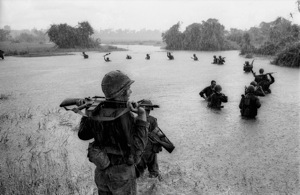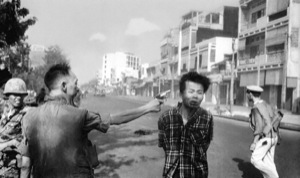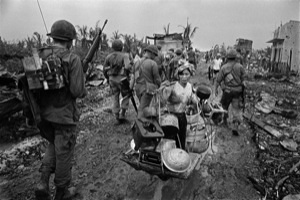Photojournalism and the Vietnam War
By Liam Kennedy
Korea was the last war that most Americans viewed primarily through photographs in print. By 1962, over 80% of American homes had television and in 1968 over 60% of Americans looked to television for news on the Vietnam war. However, the statistics do not tell us about the conditions of visual news production and its effects. Photojournalism did not quite cede the ground of news representation to television, rather these mediums existed in a relationship of mutual influence. Together, they constructed a visual grammar for looking at Vietnam. At the same time, and partly in response to the challenge of television, photojournalism evolved certain techniques that emphasized its capacity to document decisive moments and that were commensurate with the nature of the conflict in Vietnam.
As with other forms of media coverage, the volume and focus of photojournalism was largely determined by the particular conditions of this war- the technologies, the tactics and the territory- and by the shifting course of the war in relation to American public opinion, to which the media elites were very sensitive. Some photographers were full-time staffers with news agencies such as Associated Press and United Press International and news magazines such as Life, Time and Newsweek, but many more were freelancers who turned up in Vietnam hoping to have their work taken up by one of the major agencies or papers. Not all were professionally trained, yet press passes were easy to obtain and with a pass the photographer would receive support from the American military to move relatively safely as they covered the war. The large numbers of photographers and the relative autonomy that they enjoyed contributed to a new political economy of war imagery that emerged in relation to the Vietnam war, one that was very immediately responsive to and regulated by the American and other Western markets' large appetites for war imagery.
A great deal of this imagery focused on spot news and dramatic action, prerequisites to meet the demand and deadlines from the dialy and weekly papers and magazines. It was tailored to the representation of distinctive forms of combat activities and terrains, and the technologies of movement and violence. The result over time was that the published imagery repeatedly presented similar scenarios, motifs, tropes and points of view: helicopters taking off or landing; troops springing from helicopters and fanning out on foot; troops on patrol through paddy fields and wading across rivers. The helicopter became a key icon of this imagery, with point of view shots of terrain from helicopters being common. Indeed, the cameras render the helicopter, on which the photographers were very often dependent for their own movements and war coverage, the ubiquitous motif of the war, one adapted by cinema at the war's end. The result was an increasingly stylized and often distanced perspective on the war, finding its mise-en-scene in the framing of American men and machinery against inhospitable terrain. The absence of the North Vietnamese in so much of this photography was a fitting visual reflection of a war of insurgency, with no clearly defined frontline or enemy.

Henri Huet/PA
A unit of the 173rd Airborne on a patrol in the jungles near Ben Cat, 1965.
The effects of photography on public opinion were incremental as the flows of daily photographic coverage over the long term of the conflict slowly undermined military and political claims of a justifiable and winnable war. Just as significant was the impact of photography in reinforcing and making graphic particular moments of the war that fed the growing disillusionment of the American public. In a war of confusing patterns, resistant to conventional forms of interpretation, it often proved to be the still photograph rather than the moving image that framed and defined moments of insight and brought some clarity to the scenery of confusion. Often, it did so by turning the moments into symbols, transcending the local context to address more universal human concerns. This was the case with the most iconic images of the war and it is striking how potent these were and remain, displacing written and televisual journalism in popular memory of the war.
The Vietnam war has come to be symbolized by a small number of photographs, including Malcolm Browne's photograph of the self-immolation of Buddhist monk, Thich Quang Duc, who set himself alight on a Saigon street on 11 June 1963. Eddie Adams's 'Rough Justice on a Saigon Street' depicts national police chief General Hguyen Ngoc Loan executing a Viet Cong suspect by shooting him in the temple with a pistol on 1 February 1968. Ron Haeberle's photographs of the My Lai massacre on 16 March 1968 are also frequently referenced, especially the images of bodies, including many women and children, lying dead in a trench. Finally, Huynh Cong 'Nick' Ut's 'Terror of War' shows nine-year-old Kim Phuc Phan Thi running naked down a road following a napalm attack on her village on 8 June 1972. While there are many other photographs from the war that could be said to have iconic qualities, these four are likely the most widely cited and reproduced as emblematic images of the conflict. The very selection of particular images as iconic in this manner is informative about processes of media and public interpretation of the war and its relation to American values and myths.

Eddie Adams/PA
National police chief General Hguyen Ngoc Loan executing a Viet Cong suspect. Saigon, 1968.
While collectively news photography from Vietnam constituted a potent archive of a new kind of photography suited to a new kind of war and produced imagery that challenged the ideology and course of the American mission, a great deal of work was produced as spot news imagery with a conventionalized form of professional practice. There were, however, notable exceptions, photographers who worked more self-consciously to push the boundaries of photojournalistic practice. Their work reflects on the contexts and scenery of war and, while these had varied motivations and were often constrained by the broader media and state frames, they did develop the genre of photojournalism, adapting it to new conditions of warfare and technological production. These photographers produced a more meditative form of photojournalism, an afterimagery of conflicts and contexts, bound not to spot news reporting but to a more investigative framing of events. I am thinking here of photographers such as Larry Burrows, Philip Jones Griffiths, Don McCullin, Catherine Leroy, Kyoichi Sawada and Henri Huet. In Vietnam, photographers had opportunities to develop a fresh visual awareness about war and its representations, especially those who stayed for long periods or who came with investigative intent. Within the mass visual coverage of this war were examples of this new awareness, the work of photographers reflexively attuned to the style and ethos of their work as a subjective register of their relation to the war. These photographers opened up opportunities for a more expressive form of documentary representation and influenced the style of a new generation of photojournalists who emerged to prominence in the 1970s and 1980s.
Philip Jones Griffiths, a particularly uncompromising example of the 'concerned photographer', very deliberately set about producing a body of work that boldly illustrated and indicted the destructive military and cultural presence of the US in Southeast Asia. With no outlets for such imagery among the mainstream American media, he put together his book Vietnam Inc. (1971), a benchmark of war reporting and an influential marker of the authorial role of the photojournalist. There was much that was startlingly fresh and audacious about the book. It moved the camera away from the American soldier to concentrate on the Vietnamese and to document the effects of combat seen through the eyes of civilian victims. Griffiths eschewed objectivity in favour of working with a clear vision and a determination to interrogate the 'why' of the event. In this sense, he took on the role of the photographer as witness already imputed in the Magnum tradition but radicalized it by producing a more engaged, interventionist photography than his predecessors.

Philip Jones Griffiths/Magnum
Saigon, 1968.
Not surprisingly, it is the work of Western photojournalists that have most influentially shaped visual perceptions and memories of the Vietnam war. In recent years, however, examples of the imagery produced by North Vietnamese photographers during the conflict has become more visible. In Vietnam, visual images of the 'American War' have shaped cultural memory just as in the US, but they have been subject to very different conditions of visuality, powerfully influenced by the communist state, but also reflecting tensions surrounding the neoliberalization of the country and the politics of reconciliation with the US. Very few of the North Vietnamese combat photographers have had their work published- it was the initiative of several Western photographers in the early 1990s that led to the unearthing of their materials. An exhibition and book entitled Another Vietnam: Pictures of the War From the Other Side appeared in 2002. In the work of these photographers there are very few representations of death or suffering as the emphasis is on the solidarity of soldiers and wartime workers in supporting the revolutionary effort. The resourcefulness of the mostly self-taught photographers is remarkable and their viewpoint is strikingly different from that of Western photographers as they represent an army and a culture committed to victory.
Click here for 'Photojournalism and the Vietnam War' Bibliography section
Click here for 'Photojournalism and the Vietnam War' Links section


